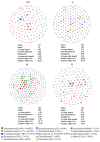Actinobacteria Emerge as Novel Dominant Soil Bacterial Taxa in Long-Term Post-Fire Recovery of Taiga Forests
- PMID: 40572151
- PMCID: PMC12195251
- DOI: 10.3390/microorganisms13061262
Actinobacteria Emerge as Novel Dominant Soil Bacterial Taxa in Long-Term Post-Fire Recovery of Taiga Forests
Abstract
The long-term post-fire recovery phase is a critical stage for forest ecosystems to progress toward regeneration and mature succession. During this process, soil bacteria exhibit greater environmental adaptability, rapidly driving nutrient cycling and facilitating vegetation restoration. This study investigated the community structure and diversity of soil bacteria during long-term recovery after forest fires in the cold temperate zone, focusing on soils from the 2000 fires in Daxing'anling. Soil samples were classified into Low (L), Moderate (M), and High (H) fire damage intensity, with bacterial community composition and diversity analyzed using Illumina sequencing technology. After long-term fire recovery, the contents of soil organic carbon, black carbon, total nitrogen, alkaline nitrogen, available phosphorus, and available potassium were significantly higher elevated (p < 0.05), and water content was significantly lower, compared with that in the control check (CK) group. Soil urease, fluorescein diacetate, soil acid phosphatase, and soil dehydrogenase activities were significantly higher, and soil sucrase activity was significantly lower in H. There was a significant difference in the Alpha diversity index among the groups. Compared with CK, the Shannon index was significantly increased (p < 0.05) in L, while both Chao1 and Shannon indices were significantly decreased (p < 0.05) in M and significantly higher in H than CK. The results of the PCoA showed that there was a significant difference in the Beta diversity of the bacterial community among the groups (R2 = 0.60 p = 0.001). The dominant bacteria groups were Proteobacteria and Acidobacteriota, while Actinobacteria became the new dominant group during the long-term post-fire recovery. AP, WC, DOC, MBC, S-DHA, and S-SC were significantly and positively correlated with soil bacterial diversity (p < 0.05). The results of the co-occurrence network analysis showed that all groups were dominated by symbiotic relationships, with M having the highest network complexity and strongest competitive effects. This study found that the physicochemical properties of soils recovered over a long period of time after fire returned to or exceeded the unfired forest condition. The Actinobacteria phylum became a new dominant bacterial group, with stronger network complexity and competition, in the process of forest recovery after moderate fire.
Keywords: diversity; dominant species; long-term post-fire recovery; soil bacteria; taiga forests.
Conflict of interest statement
The authors declare no conflicts of interest.
Figures







Similar articles
-
[Effect of Biochar-based Fertilizer Application on Soil Enzyme Activity, Fungal Community, and Crop Yield in Winter Wheat-Summer Maize Rotation Farmland].Huan Jing Ke Xue. 2025 Jun 8;46(6):3965-3974. doi: 10.13227/j.hjkx.202405297. Huan Jing Ke Xue. 2025. PMID: 40582831 Chinese.
-
Effects of fire intensity on soil microbial diversity and nitrogen cycling functional genes in forests (Northeast China).Front Microbiol. 2025 Jul 25;16:1615520. doi: 10.3389/fmicb.2025.1615520. eCollection 2025. Front Microbiol. 2025. PMID: 40785784 Free PMC article.
-
Systemic pharmacological treatments for chronic plaque psoriasis: a network meta-analysis.Cochrane Database Syst Rev. 2021 Apr 19;4(4):CD011535. doi: 10.1002/14651858.CD011535.pub4. Cochrane Database Syst Rev. 2021. Update in: Cochrane Database Syst Rev. 2022 May 23;5:CD011535. doi: 10.1002/14651858.CD011535.pub5. PMID: 33871055 Free PMC article. Updated.
-
[Effects of Long-term Corn Stover Return on Fungal Communities and Enzyme Activities in Brown Soil].Huan Jing Ke Xue. 2025 Jul 8;46(7):4699-4709. doi: 10.13227/j.hjkx.202406205. Huan Jing Ke Xue. 2025. PMID: 40677082 Chinese.
-
Systemic pharmacological treatments for chronic plaque psoriasis: a network meta-analysis.Cochrane Database Syst Rev. 2017 Dec 22;12(12):CD011535. doi: 10.1002/14651858.CD011535.pub2. Cochrane Database Syst Rev. 2017. Update in: Cochrane Database Syst Rev. 2020 Jan 9;1:CD011535. doi: 10.1002/14651858.CD011535.pub3. PMID: 29271481 Free PMC article. Updated.
References
-
- Zhao Z., Wang L.Z., Li H.R., Wei C.L., Zhao H.K., Jie X. Grass-Larix gmelinii Forest in Permafrost Region of Cold Temperate Zone Community Characteristics of Natural Regeneration After Fire. J. Temp. For. Res. 2021;4:25–31. doi: 10.3969/j.issn.2096-4900.2021.02.005. - DOI
-
- Fernández-González A.J., Martínez-Hidalgo P., Cobo-Díaz J.F., Villadas P.J., Martínez-Molina E., Toro N., Tringe S.G., Fernández-López M. The rhizosphere microbiome of burned holm-oak: Potential role of the genus Arthrobacter in the recovery of burned soils. Sci. Rep. 2017;7:6008. doi: 10.1038/s41598-017-06112-3. - DOI - PMC - PubMed
-
- Fultz L.M., Moore-Kucera J., Dathe J., Davinic M., Perry G., Wester D., Schwilk D.W., Rideout-Hanzak S. Forest wildfire and grassland prescribed fire effects on soil biogeochemical processes and microbial communities: Two case studies in the semi-arid Southwest. Appl. Soil Ecol. 2016;99:118–128. doi: 10.1016/j.apsoil.2015.10.023. - DOI
-
- Neary D.G., Klopatek C.C., DeBano L.F., Ffolliott P.F. Fire effects on belowground sustainability: A review and synthesis. For. Ecol. Manag. 1999;122:51–71. doi: 10.1016/S0378-1127(99)00032-8. - DOI
Grants and funding
LinkOut - more resources
Full Text Sources
Research Materials
Miscellaneous

